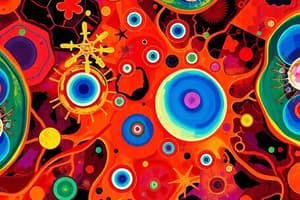Podcast
Questions and Answers
What does the cell theory state regarding cells?
What does the cell theory state regarding cells?
- All cells are identical in structure and function.
- Cells can exist independently of other cells.
- All living organisms are composed of cells. (correct)
- Cells arise spontaneously from non-living matter.
Which type of bond involves the transfer of electrons between a metal and a nonmetal?
Which type of bond involves the transfer of electrons between a metal and a nonmetal?
- Ionic bond (correct)
- Hydrogen bond
- Metallic bond
- Covalent bond
In the context of atomic structure, what does the atomic number represent?
In the context of atomic structure, what does the atomic number represent?
- The total number of protons and neutrons
- The number of protons in the nucleus (correct)
- The number of isotopes of an element
- The number of electrons in an atom
What is the primary process by which organisms adapt to their environment?
What is the primary process by which organisms adapt to their environment?
Which of the following is NOT a component of an ecosystem?
Which of the following is NOT a component of an ecosystem?
What describes the energy stored in an object due to its position?
What describes the energy stored in an object due to its position?
Which reaction type involves the transfer of electrons?
Which reaction type involves the transfer of electrons?
Which of the following correctly describes how elements are organized in the periodic table?
Which of the following correctly describes how elements are organized in the periodic table?
What does Newton's first law of motion entail?
What does Newton's first law of motion entail?
Which of the following is a characteristic of Mendelian inheritance?
Which of the following is a characteristic of Mendelian inheritance?
Flashcards are hidden until you start studying
Study Notes
Biology
-
Cell Theory
- All living organisms are composed of cells.
- The cell is the basic unit of life.
- All cells arise from pre-existing cells.
-
Genetics
- DNA is the hereditary material.
- Genes are segments of DNA that code for proteins.
- Mendelian inheritance: Dominant and recessive traits.
-
Evolution
- Natural selection is the process by which organisms adapt to their environment.
- Speciation occurs when populations evolve to become distinct species.
- Evidence includes fossil records, genetic similarities, and anatomical homologies.
-
Ecology
- Ecosystems consist of biotic (living) and abiotic (non-living) components.
- Food chains and food webs illustrate energy flow.
- Biomes are large ecological areas with distinct climates and organisms.
Chemistry
-
Atomic Structure
- Atoms consist of protons, neutrons, and electrons.
- The atomic number indicates the number of protons.
- Isotopes are variants of elements with different neutron counts.
-
Chemical Bonds
- Ionic bonds form between metals and nonmetals by transferring electrons.
- Covalent bonds involve the sharing of electrons between nonmetals.
- Metallic bonds involve a 'sea of electrons' among metal atoms.
-
Reactions
- Combustion reactions produce energy and carbon dioxide.
- Redox reactions involve the transfer of electrons.
- Acid-base reactions neutralize acids with bases to form water and salts.
-
Periodic Table
- Organized by increasing atomic number.
- Groups indicate elements with similar properties.
- Periods show trends in reactivity and properties across rows.
Physics
-
Forces and Motion
- Newton's laws of motion describe the relationship between forces and motion.
- The principle of inertia states an object in motion stays in motion unless acted upon.
- Force equals mass times acceleration (F=ma).
-
Energy
- Kinetic energy is the energy of motion; potential energy is stored energy.
- The law of conservation of energy states energy cannot be created or destroyed.
- Different forms of energy include thermal, mechanical, chemical, and nuclear.
-
Waves and Sound
- Waves transfer energy through oscillations, including mechanical and electromagnetic waves.
- Sound waves are longitudinal waves that require a medium to travel.
- The frequency determines the pitch, and amplitude affects loudness.
-
Electricity and Magnetism
- Electric current is the flow of electric charge.
- Ohm’s law relates voltage, current, and resistance (V=IR).
- Magnetism is produced by moving electric charges, and electromagnets can be created by coiling wire and applying current.
Biology
- All living organisms consist of cells, which are the fundamental units of life.
- Cells originate from pre-existing cells, emphasizing the continuity of life.
- DNA serves as hereditary material, encoding genetic information through segments known as genes.
- Mendelian inheritance describes how traits are passed through dominant and recessive alleles.
- Natural selection drives adaptation in organisms based on environmental pressures, leading to evolutionary changes.
- Speciation occurs when populations diverge genetically over time, resulting in distinct species.
- Evidence supporting evolution includes fossil records, genetic similarities among species, and anatomical homologies that show evolutionary relationships.
- Ecosystems are formed from biotic (living) and abiotic (non-living) elements, creating complex interactions.
- Energy flow in ecosystems is represented through food chains and food webs, illustrating the transfer of energy from producers to consumers.
- Biomes are categorized ecological regions defined by specific climate conditions and characteristic organisms.
Chemistry
- Atoms, the fundamental units of matter, are made up of protons, neutrons, and electrons.
- The atomic number of an element reflects the number of protons found in its nucleus, defining the element.
- Isotopes are variations of elements differing only in neutron counts, affecting atomic mass.
- Ionic bonds are formed through the transfer of electrons from metals to nonmetals, resulting in charged ions.
- Covalent bonds arise from the sharing of electrons between nonmetal atoms, creating stable molecules.
- Metallic bonds create a 'sea of electrons' that allows metal atoms to share electrons freely and conduct electricity.
- Combustion reactions generate energy alongside carbon dioxide as a byproduct, commonly seen in fuels.
- Redox (reduction-oxidation) reactions involve the transfer of electrons, crucial for energy transfers in chemical processes.
- Acid-base reactions neutralize acids with bases to produce water and salts, fundamental in various chemical contexts.
- The periodic table arranges elements by increasing atomic number, facilitating the study of chemical properties.
- Elements in the same group exhibit similar chemical behaviors, while elements in each period show changing reactivity and properties.
Physics
- Newton's laws of motion explain the dynamics of forces and how they impact object movement.
- The principle of inertia asserts that an object's state of motion remains unchanged unless acted upon by an external force.
- The formula for force (F=ma) indicates that force is the product of mass and acceleration, revealing the interconnectedness of these quantities.
- Kinetic energy relates to motion, whereas potential energy represents stored energy that can be converted into kinetic energy.
- The law of conservation of energy states that energy can neither be created nor destroyed but can change forms.
- Different energy types include thermal (heat), mechanical (motion), chemical (stored in bonds), and nuclear (from atomic reactions).
- Waves represent energy transfer through oscillations, categorized into mechanical waves (requiring a medium) and electromagnetic waves (capable of traveling through a vacuum).
- Sound waves, which are longitudinal and dependent on a medium for travel, have properties defined by frequency (pitch) and amplitude (loudness).
- Electric current refers to the movement of electric charge, with Ohm's law (V=IR) governing the relationship between voltage, current, and resistance.
- Magnetism is a phenomenon produced by moving electric charges, with electromagnets created by coiling wire and passing an electric current through it.
Studying That Suits You
Use AI to generate personalized quizzes and flashcards to suit your learning preferences.



